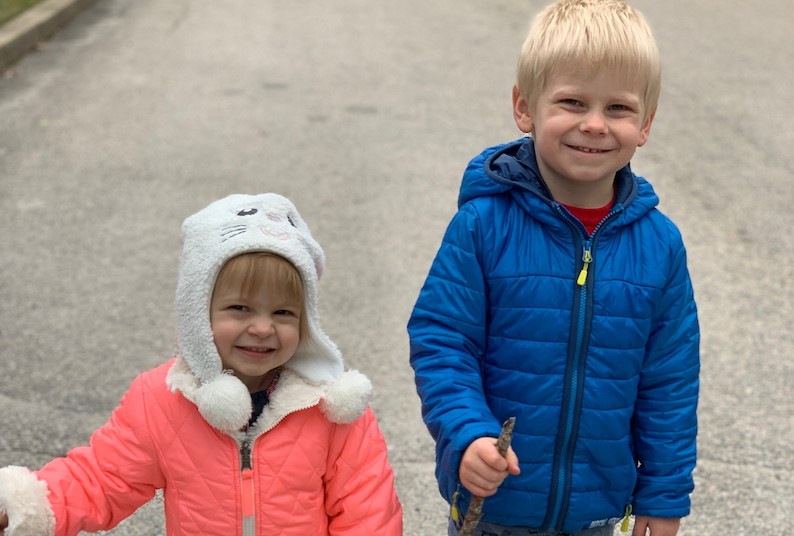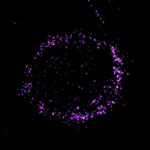Anabella’s story: Hope for treating malignant rhabdoid tumors

Watching her deftly maneuver a playground with a huge smile on her face makes it hard to imagine that Anabella Trillo, 3, once faced challenges far greater than a jungle gym. In fact, she has already endured surgery, radiation, chemotherapy, and a stem cell transplant for one of the most aggressive pediatric cancers: a malignant rhabdoid tumor.
Most commonly occurring in infants and toddlers, rhabdoid tumors are extremely rare: There are only 20 to 25 new cases diagnosed each year in the United States. Usually starting in the kidneys, the disease can also arise in other soft tissues and is closely related to another aggressive tumor, ATRT, that occurs in the brain. No matter where it originates, it can quickly spread to other parts of the body. Even if successfully treated at first, many patients relapse.
A tumor was far from the mind of Anabella’s father, Joe, when he sat her down on the couch to watch TV one night in August 2017. The family, which also includes Anabella’s mom Izabela and big brother Michael, had just returned home to Rhode Island from a beach vacation in Florida.
“Anabella turned her head, and I noticed a bump on her neck, a little smaller than a golf ball,” Joe remembers. “I didn’t like the look of it, so we called the pediatrician right away. The next thing you know, she was getting all kinds of scans and x-rays.”
Cancer diagnosis prompts a trip to Boston
After several days of tests, a local hospital in Rhode Island confirmed the bump was cancerous. This prompted Joe to act.
“My grandfather had been treated for cancer up in Boston, at Dana-Farber,” says Joe. “I knew that’s where we needed to take Anabella.”
Doctors at Dana-Farber/Boston Children’s Cancer and Blood Disorders Center quickly determined Anabella had a malignant rhabdoid tumor. Learning the many side effects of treatment — and the high rate of recurrence — was devastating news for Joe and Izabela. They were buoyed, however, by an experienced care team, including oncologist Dr. Elizabeth Mullen.
Because it has handled more rhabdoid tumors cases than most other hospitals, Dana-Farber/Boston Children’s is recognized as a referral center for the disease. Dr. Mullen says that in addition to treating several of her own rhabdoid patients, she is increasingly contacted by doctors around the country who have diagnosed a child with this disease and are seeking guidance.

“Malignant rhabdoid tumors are resistant to many of our standard treatments, including intensive chemotherapy,” says Dr. Mullen. “Although it often has an initial response to treatment, it very often comes back very quickly. It also occurs, as in Anabella, in places in the body where it is very difficult to remove the whole tumor surgically, which is a critical part of treating this cancer.”
Treatment and transplant
Dr. Mullen and her colleagues recommended that after her initial rounds of intensive chemotherapy, Anabella undergo a stem cell transplant and then proton radiation to the tumor. This was planned to replace surgical removal of the tumor, which was not possible for Anabella.
“The goal was for the radiation to act as local control, instead of surgery,” explains Mullen. “Because it was also not possible for her to receive chemotherapy during the six weeks of intensive proton therapy, her chemotherapy was consolidated upfront, and Anabella received back her own stem cells to recover from it.”
Joe says the aggressive treatment approach, which included many months of inpatient care and numerous side effects, was hard for the family to handle. He credits Dr. Mullen and nurse practitioner Casey Wall for helping them through it.
“I’ve never seen a team work so well together, and so professionally,” says Joe. “Dr. Mullen and Casey were like the captains of the ship, and we had utmost confidence that they were making the best decisions for Anabella.”
Follow-up treatment
Anabella finished her active treatment in May 2018. These days, her only regular visits to Dana-Farber/Boston Children’s are for checkups every four to six months. She runs enthusiastically into her appointments with Dr. Mullen and Wall, whom she remembers fondly.
The Trillo family knows that Anabella’s cancer can still come back, and that other late effects, including serious ones like secondary cancers, are also a possibility. Dr. Mullen says that because Anabella has gone more than a year without a relapse, the chances of one are less likely — but the treatment team still needs to be vigilant about late effects.
“Right now, however, she is in a very good place,” Dr. Mullen says. “When you meet her, it is impossible to know that she went through any therapy at all.”
Trials target SMARCB1 gene
While the Trillos look forward with confidence, researchers are doing the same. Although there is no clear cause for malignant rhabdoid tumors, scientists have discovered that a gene called SMARCB1 (which also goes by the names INI1, SNF5, and BAF47) is mutated in nearly all forms of this cancer — including the atypical teratoid rhabdoid tumors (ATRT) found in the brain and central nervous system.
“There are clinical trials under way at Dana-Farber/Boston Children’s and around the country to try and take on this cancer in a more directed way, with targeted therapy,” says Dr. Mullen. “Given the explosion in understanding of the underlying biology, I am certain that there will be more of them. To date, no targeted therapy has been found that can promise a cure for children of this disease, but new therapies are already having some impact.”
In the meantime, she adds, strong responses and good outcomes like Anabella’s are critical for others to see.
“The number one thing we need to meet every family with is hope,” says Dr. Mullen. “Our hope is always to cure.”
This post originally appeared on Insight, the blog of the Dana-Farber Cancer Institute.
Learn more about the Dana-Farber/Boston Children’s Cancer and Blood Disorders Center.
Related Posts :
-

A true hero’s journey: How a team approach helped Wolfie overcome pancreatitis
Wolfgang, affectionately known as “Wolfie,” is a bright and energetic 7-year-old with a quick wit and a love for making ...
-

A toast to BRD4: How acidity changes the immune response
It started with wine. Or more precisely, a conversation about it. "My colleagues and I were talking about how some ...
-

A new druggable cancer target: RNA-binding proteins on the cell surface
In 2021, research led by Ryan Flynn, MD, PhD, and his mentor, Nobel laureate Carolyn Bertozzi, PhD, opened a new chapter ...
-

Forecasting the future for childhood cancer survivors
Children are much more likely to survive cancer today than 50 years ago. Unfortunately, as adults, many of them develop cardiovascular ...





